第八章-练习题
思修第八章习题
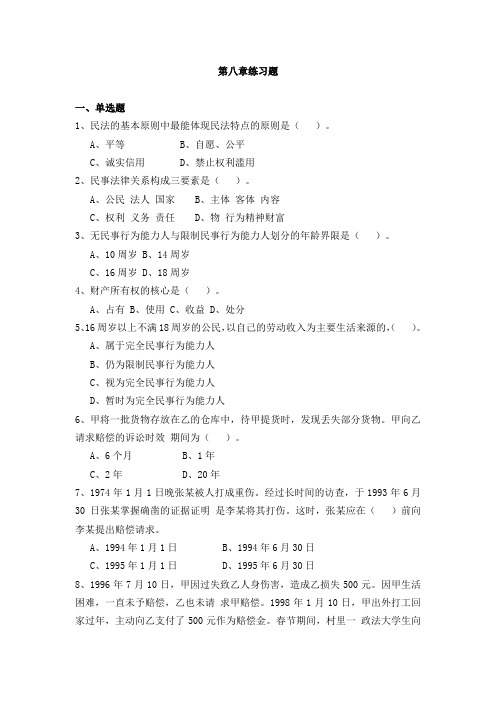
第八章练习题一、单选题1、民法的基本原则中最能体现民法特点的原则是()。
A、平等B、自愿、公平C、诚实信用D、禁止权利滥用2、民事法律关系构成三要素是()。
A、公民法人国家B、主体客体内容C、权利义务责任D、物行为精神财富3、无民事行为能力人与限制民事行为能力人划分的年龄界限是()。
A、10周岁B、14周岁C、16周岁D、18周岁4、财产所有权的核心是()。
A、占有B、使用C、收益D、处分()。
5、16周岁以上不满18周岁的公民,以自己的劳动收入为主要生活来源的,A、属于完全民事行为能力人B、仍为限制民事行为能力人C、视为完全民事行为能力人D、暂时为完全民事行为能力人6、甲将一批货物存放在乙的仓库中,待甲提货时,发现丢失部分货物。
甲向乙请求赔偿的诉讼时效期间为()。
A、6个月B、1年C、2年D、20年7、1974年1月1日晚张某被人打成重伤。
经过长时间的访查,于1993年6月30日张某掌握确凿的证据证明是李某将其打伤。
这时,张某应在()前向李某提出赔偿请求。
A、1994年1月1日B、1994年6月30日C、1995年1月1日D、1995年6月30日8、1996年7月10日,甲因过失致乙人身伤害,造成乙损失500元。
因甲生活困难,一直未予赔偿,乙也未请求甲赔偿。
1998年1月10日,甲出外打工回家过年,主动向乙支付了500元作为赔偿金。
春节期间,村里一政法大学生向村民进行普法教育,甲才明白该笔赔偿已过诉讼时效,此时,()。
A、甲有权要求乙返还500元的赔偿金B、乙接收500元属于不当得利C、乙有权接收该500元,甲无权请求返还D、乙无权接收,该500元应收归国家或集体所有9、我国民法通则规定的诉讼时效中止,中止的原因发生在诉讼时效期间的()。
A、最后1年内B、最后6个月内C、任何时间D、最后3个月内10、甲男乙女欲登记结婚,因筹备婚礼事务繁多,故请好友丙男丁女代领结婚证书。
丙男丁女()。
A、属委托代理B、属指定代理C、有权代理D、不得代理11、何某有一栋可以眺望海景的别墅,当他得知有一栋大楼将要建设,从此别墅不能再眺望海景时,就将别墅卖给想得到一套可眺望海景的房屋的张某。
初二物理第八章练习题含答案
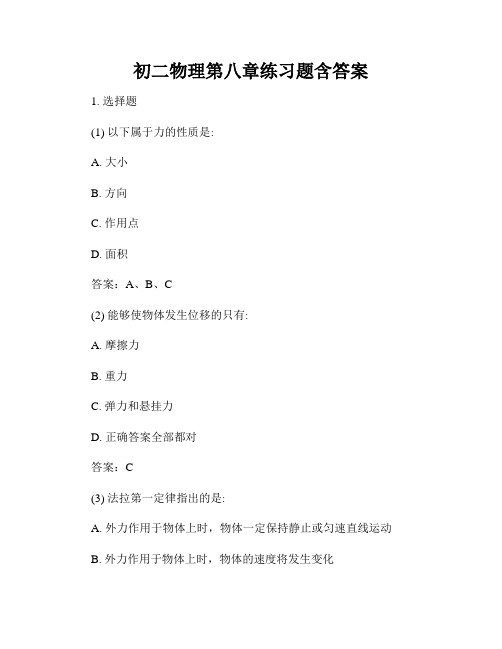
初二物理第八章练习题含答案1. 选择题(1) 以下属于力的性质是:A. 大小B. 方向C. 作用点D. 面积答案:A、B、C(2) 能够使物体发生位移的只有:A. 摩擦力B. 重力C. 弹力和悬挂力D. 正确答案全部都对答案:C(3) 法拉第一定律指出的是:A. 外力作用于物体上时,物体一定保持静止或匀速直线运动B. 外力作用于物体上时,物体的速度将发生变化C. 物体受到的合力为零时,物体一定保持静止或匀速直线运动D. 物体受到的合力为零时,物体的速度将发生变化答案:C2. 填空题(1) 一个力从右往左作用于一个物体,这个物体产生的反作用力的方向是______。
答案:从左往右(2) 一个力从上往下作用于一个物体,这个物体产生的反作用力的方向是______。
答案:从下往上(3) 一个物体受到A力的作用产生加速度a,如果力A的大小不变,改变作用方向,则产生的加速度为______。
答案:-a3. 解答题(1) 什么是力?力的三要素是什么?解答:力是物体之间相互作用的结果,是导致物体发生变化的原因。
力的三要素包括大小、方向和作用点。
大小表示力的强弱程度,方向表示力作用的直线方向,作用点表示力作用的具体位置。
(2) 什么是合力?如何求合力?解答:合力是同时作用在物体上的多个力的共同效果。
求合力的方法是将所有作用在物体上的力按照大小和方向合成,可以通过向量法或图示法来求解。
(3) 描述牛顿第一定律,并用实例说明其应用。
解答:牛顿第一定律也称为惯性定律,指出在没有外力作用时,物体将保持静止或匀速直线运动的状态。
例如,当我们用力推动一张光滑的桌子上的书时,如果力的大小和方向适当,书就会保持匀速直线运动,直到受到其他力的作用。
这说明物体在没有外力干扰时具有惯性,保持原来的状态不发生变化。
总结:初二物理第八章练习题主要涉及力的性质和作用、法拉第一定律等内容。
通过选择题和填空题加深对知识点的理解,同时通过解答题展开思考和拓展。
2019年中级财务管理-第八章-成本管理练习题
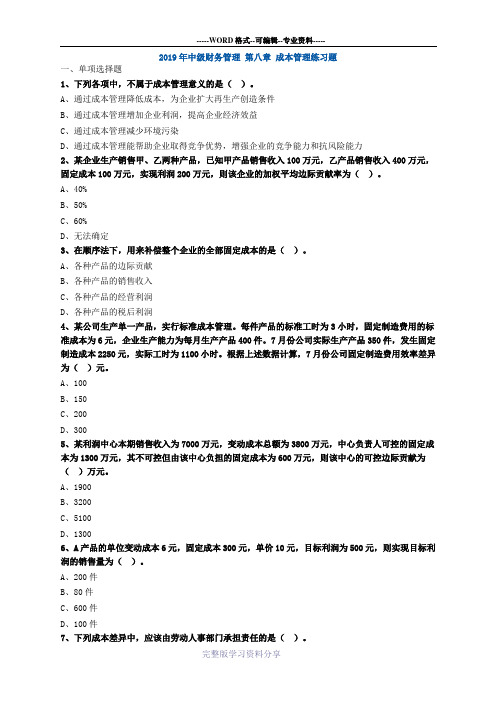
2019年中级财务管理第八章成本管理练习題一、单项选择题1、下列各项中,不属于成本管理意义的是()。
A、通过成本管理降低成本,为企业扩大再生产创造条件B、通过成本管理增加企业利润,提高企业经济效益C、通过成本管理减少环境污染D、通过成本管理能帮助企业取得竞争优势,增强企业的竞争能力和抗风险能力2、某企业生产销售甲、乙两种产品,已知甲产品销售收入100万元,乙产品销售收入400万元,固定成本100万元,实现利润200万元,则该企业的加权平均边际贡献率为()。
A、40%B、50%C、60%D、无法确定3、在顺序法下,用来补偿整个企业的全部固定成本的是()。
A、各种产品的边际贡献B、各种产品的销售收入C、各种产品的经营利润D、各种产品的税后利润4、某公司生产单一产品,实行标准成本管理。
每件产品的标准工时为3小时,固定制造费用的标准成本为6元,企业生产能力为每月生产产品400件。
7月份公司实际生产产品350件,发生固定制造成本2250元,实际工时为1100小时。
根据上述数据计算,7月份公司固定制造费用效率差异为()元。
A、100B、150C、200D、3005、某利润中心本期销售收入为7000万元,变动成本总额为3800万元,中心负责人可控的固定成本为1300万元,其不可控但由该中心负担的固定成本为600万元,则该中心的可控边际贡献为()万元。
A、1900B、3200C、5100D、13006、A产品的单位变动成本6元,固定成本300元,单价10元,目标利润为500元,则实现目标利润的销售量为()。
A、200件B、80件C、600件D、100件7、下列成本差异中,应该由劳动人事部门承担责任的是()。
A、直接材料价格差异B、直接人工工资率差异C、直接人工效率差异D、变动制造费用效率差异8、某企业每月固定制造费用20000元,固定销售费用5000元,固定管理费用50000元。
单位变动制造成本50元,单位变动销售费用9元,单位变动管理费用1元。
第八章 财务会计报告练习题

【例题49·判断题】2008年12月31日,某公司“长期借款”账户贷方余额520000元,其中,2009年7月1日到期的借款为200000元,则当日编制的资产负债表中,“长期借款”项目的“期末余额”应为320000元。( )
【答案】对
【例题50·不定向选择题】某公司2010年12月31日部分账户的余额资料如下表:
A.月末B.季末C.半年度D.年末
【答案】A
【例题23·单选题】反映企业在某一特定日期财务状况的会计报表是( )。
A.资产负债表B.利润表C.现金流量表D.利润分配表
【答案】A
【例题24·单选题】资产负债表的项目( )。
A.都可以按账户余额直接填列
B.必须对账户发生额进行分析计算才能填列
C.多数项目可以直接根据账户余额填列,少数报表项目需要根据账户发生额分析计算后才能填列
A.单位负责人B.总会计师C.会计机构负责人D.单位内部审计人员
【答案】ABC
【例题8·多选题】财务会计报告的编制要求包括( )等。
A.真实可靠B.全面完整C.便于理解D.适度谨慎
【答案】ABC
【例题9·多选题】会计报表按反映的经济内容分类可分为( )。
A.内部报表B.财务报表C.静态报表D.动态报表
A.700
B.770
C.890
D.960
【答案】A
【例题30·单选题】资产负债表的下列项目中,需根据若干个总账账户余额相加计算填列的是( )。
A.应收账款B.固定资产
C.货币资金D.其他应收款
【答案】C
【例题31·单选题】资产负债表的下列项目中,可以根据总账账户余额直接填列的是( )。
A.应付职工薪酬B.存货
D.多数项目可以直接根据账户余额填列,少数报表项目需要根据账户余额分析计算后才能填列
第八章电化学练习题
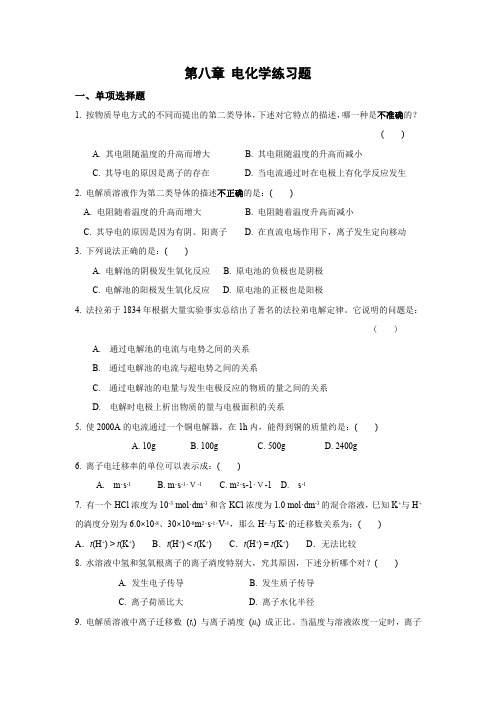
第八章电化学练习题一、单项选择题1.按物质导电方式的不同而提出的第二类导体,下述对它特点的描述,哪一种是不准确的?()A.其电阻随温度的升高而增大B.其电阻随温度的升高而减小C.其导电的原因是离子的存在D.当电流通过时在电极上有化学反应发生2.电解质溶液作为第二类导体的描述不正确的是:()A.电阻随着温度的升高而增大B.电阻随着温度升高而减小C.其导电的原因是因为有阴、阳离子D.在直流电场作用下,离子发生定向移动3.下列说法正确的是:()A.电解池的阴极发生氧化反应B.原电池的负极也是阴极C.电解池的阳极发生氧化反应D.原电池的正极也是阳极4.法拉弟于1834年根据大量实验事实总结出了著名的法拉弟电解定律。
它说明的问题是:()A.通过电解池的电流与电势之间的关系B.通过电解池的电流与超电势之间的关系C.通过电解池的电量与发生电极反应的物质的量之间的关系D.电解时电极上析出物质的量与电极面积的关系5.使2000A的电流通过一个铜电解器,在1h内,能得到铜的质量约是:()A.10gB.100gC.500gD.2400g6.离子电迁移率的单位可以表示成:()A.m·s-1B.m·s-1·V-1C.m2·s-1·V-1D.s-17.有一个HCl浓度为10-3mol·dm-3和含KCl浓度为1.0mol·dm-3的混合溶液,巳知K+与H+的淌度分别为6.0×10-8、30×10-8m2·s-1·V-1,那么H+与K+的迁移数关系为:()A.t(H+)>t(K+)B.t(H+)<t(K+)C.t(H+)=t(K+)D.无法比较8.水溶液中氢和氢氧根离子的离子淌度特别大,究其原因,下述分析哪个对?()A.发生电子传导B.发生质子传导C.离子荷质比大D.离子水化半径9.电解质溶液中离子迁移数(t i)与离子淌度(u i)成正比。
第八章 借款费用练习题及答案

第八章借款费用一、单项选择题1.专门借款是指()。
A.为购建或者生产符合资本化条件的资产而专门借入的款项B.发行债券收款C.长期借款D.技术改造借款2.借款费用资本化时,与专门借款有关的利息收入应()。
A.计入财务费用B.冲减购建的资产成本C.计入营业外收入D.冲减借款费用资本化金额2.不属于借款费用的是()。
3.借款手续费 B.发行公司债券佣金 C.借款利息 D.发行股票佣金4.予以资本化的借款费用计入()。
A.资产的成本B.财务费用C.借款费用D.当期损益5.下列哪种情况不应暂停借款费用资本化()。
A.由于劳务纠纷而造成连续超过3个月的固定资产的建造中断B.由于资金周转困难而造成连续超过3个月的固定资产的建造中断C.由于发生安全事故而造成连续超过3个月的固定资产的建造中断D.由于可预测的气候影响而造成连续超过3个月的固定资产的建造中断6.当所购建的固定资产()时,应当停止借款费用的资本化。
A.达到预定可使用状态B.交付使用C.竣工决算D.交付使用并办理竣工决算手续7.下列符合资本化条件的资产发生的借款费用予以资本化时,要与资产支出挂钩的有()。
A.专门借款利息B.专门借款的溢价摊销C.一般借款利息D.外币专门借款的汇兑差额8.甲公司于2014年3月1日决定建造厂房。
4月5日借入专门借款5000万元,4月10日购入建造厂房用钢材500万元,当日用银行存款支付。
4月15日厂房正式动工兴建。
甲公司专门借款利息开始资本化的时间为()。
A.4月5日B.4月10日C.4月15日D.4月30日9.生产经营期间,如果某项固定资产的购建发生非正常中断,并且中断时间超过3个月(含3个月),应当将中断期间所发生的借款费用,记入()账户。
A.制造费用B.在建工程C.营业外支出D.财务费用10.甲公司为建造自用仓库于2014年1月1日借入2年期、年利率为10%的专门借款 4 000万元。
此外,甲公司在2013年11月1日还借入了年利率为8%的一般借款2 000万元。
第八章 时间序列分析 思考题及练习题
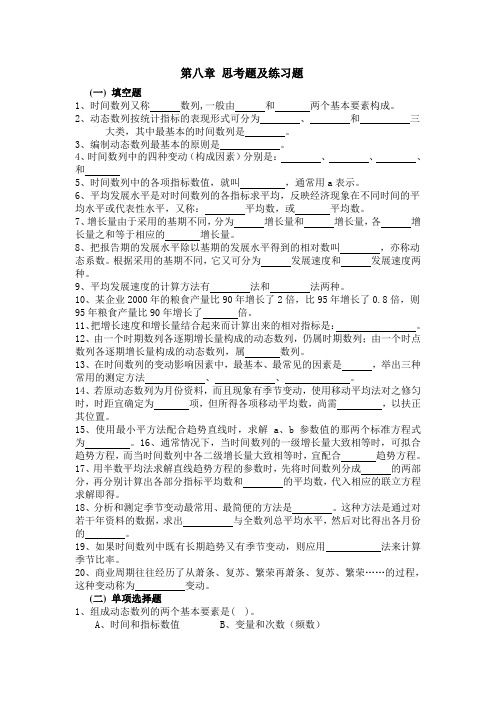
第八章思考题及练习题(一) 填空题1、时间数列又称数列,一般由和两个基本要素构成。
2、动态数列按统计指标的表现形式可分为、和三大类,其中最基本的时间数列是。
3、编制动态数列最基本的原则是。
4、时间数列中的四种变动(构成因素)分别是:、、、和5、时间数列中的各项指标数值,就叫,通常用a表示。
6、平均发展水平是对时间数列的各指标求平均,反映经济现象在不同时间的平均水平或代表性水平,又称:平均数,或平均数。
7、增长量由于采用的基期不同,分为增长量和增长量,各增长量之和等于相应的增长量。
8、把报告期的发展水平除以基期的发展水平得到的相对数叫,亦称动态系数。
根据采用的基期不同,它又可分为发展速度和发展速度两种。
9、平均发展速度的计算方法有法和法两种。
10、某企业2000年的粮食产量比90年增长了2倍,比95年增长了0.8倍,则95年粮食产量比90年增长了倍。
11、把增长速度和增长量结合起来而计算出来的相对指标是:。
12、由一个时期数列各逐期增长量构成的动态数列,仍属时期数列;由一个时点数列各逐期增长量构成的动态数列,属数列。
13、在时间数列的变动影响因素中,最基本、最常见的因素是,举出三种常用的测定方法、、。
14、若原动态数列为月份资料,而且现象有季节变动,使用移动平均法对之修匀时,时距宜确定为项,但所得各项移动平均数,尚需,以扶正其位置。
15、使用最小平方法配合趋势直线时,求解 a、b参数值的那两个标准方程式为。
16、通常情况下,当时间数列的一级增长量大致相等时,可拟合趋势方程,而当时间数列中各二级增长量大致相等时,宜配合趋势方程。
17、用半数平均法求解直线趋势方程的参数时,先将时间数列分成的两部分,再分别计算出各部分指标平均数和的平均数,代入相应的联立方程求解即得。
18、分析和测定季节变动最常用、最简便的方法是。
这种方法是通过对若干年资料的数据,求出与全数列总平均水平,然后对比得出各月份的。
19、如果时间数列中既有长期趋势又有季节变动,则应用法来计算季节比率。
第八章 财管练习题
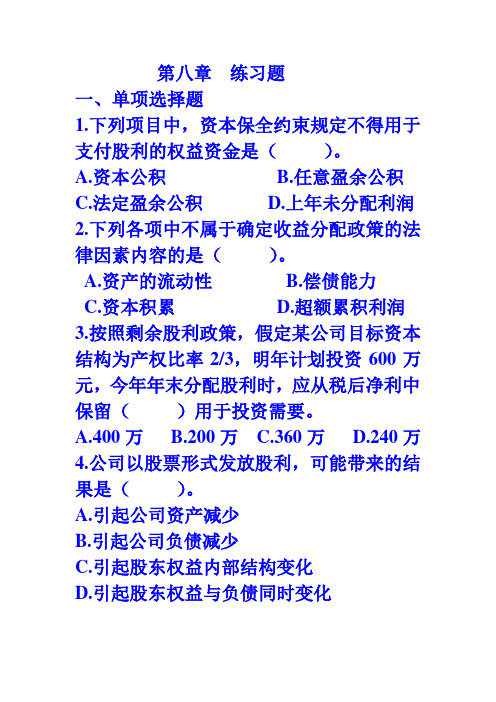
第八章练习题一、单项选择题1.下列项目中,资本保全约束规定不得用于支付股利的权益资金是()。
A.资本公积B.任意盈余公积C.法定盈余公积D.上年未分配利润2.下列各项中不属于确定收益分配政策的法律因素内容的是()。
A.资产的流动性B.偿债能力C.资本积累D.超额累积利润3.按照剩余股利政策,假定某公司目标资本结构为产权比率2/3,明年计划投资600万元,今年年末分配股利时,应从税后净利中保留()用于投资需要。
A.400万B.200万C.360万D.240万4.公司以股票形式发放股利,可能带来的结果是()。
A.引起公司资产减少B.引起公司负债减少C.引起股东权益内部结构变化D.引起股东权益与负债同时变化5.某企业当年净利润为300万元,年初累计亏损为500万元,法定盈余公积金提取比例为10%,则当年可提取的法定盈余公积为()万元。
A.20B.0C.30D.806.容易造成股利支付额与本期净利相脱节的股利分配政策是()A.剩余股利政策B.固定股利政策C.固定股利支付率政策D.低正常股利加额外股利政策7.除息日开始,()。
A.股利权从属于股票B.股利宣告发放C.股利权与股票相分离D.持有股票者享有领取股利的权利8.某公司现有发行在外的普通股1 00万股,每股面额1元,资本公积300万元,未分配利润800万元,股票市价20元,若按10%的比例发放股票股利并按市价折算,公司资本公积的报表列示将为()。
A.100万元B.290万元C.490万元D.300万元9.股利分配涉及的方面很多,但其中最主要的是确定()。
A.股利的各种支付形式B.各种股利分配政策C.股利支付程序中的各个日期D.股利的支付比率10.()比较适用于那些稳定发展且财务状况也较稳定的公司。
A.剩余股利政策B.固定股利政策C.固定股利支付率政策D.低正常股利加额外股利政策11.企业采用剩余股利分配政策的根本理由是()。
A.最大限度地用收益满足筹资的需要B.向市场传递企业不断发展的信息C.使企业保持理想的资本结构D.使企业在资金使用上有较大的灵活性12.固定股利支付率政策是指()。
第八章 对外投资管理 练习题

第八章对外投资管理练习题一、单选题1、债券到期收益率计算的原理是()。
A.到期收益率是购买债券后一直持有到期的内含报酬率B.到期收益率是能使债券每年利息收入的现值等于债券买入价格的折现率C.到期收益率是债券利息收益率与资本利得收益率之和D.到期收益率的计算要以债券每年末计算并支付利息、到期一次还本为前提2、对证券持有人而言,证券发行人无法按期支付利息、偿付本金的风险是()风险。
A.流动性B.系统C.违约D.购买力3、以下不属于企业长期股票投资目的的项目是()。
A.满足未来投资需要B.控制被投资企业C.保持资产的流动性D.降低自身经营风险4、股票的投资收益不包括()。
A.股利收益B.资本利得C.转让收益D.利息收益5、某公司股票目前发放的股利为每股2元,股利按10%的比例固定递增,据此计算出的资本成本为15%,则该股票目前的市价为()。
A.44B.13C.30.45D.35.56、当市场利率大于债券票面利率时,一般应采用的发行方式为()。
A.溢价发行B.折价发行C.面值发行D.按市价发行7、在证券投资中,因通货膨胀带来的风险是()。
A.违约风险B.利率风险C.购买力风险D.变现力风险8、在投资人想出售有价证券获取现金时,证券不能立即出售的风险被称为()。
A.违约风险B.购买力风险C.变现力风险D.再投资风险9、下列投资中,风险最小的是()。
A.购买政府债券B.购买企业债券C.购买股票D.投资开发项目10、某投资者持有甲、乙、丙三种股票,三种股票所占资金的比例分别为20%、30%、50%,其ß系数分别为1.2、0.8、1.8,则综合ß系数为()。
A.1.8B.3.8C.1.38D.1.58二、多选题1、在复利计息、到期一次还本的条件下,债券每期票面利率与到期收益率不一致的情况有()。
A.债券平价发行,每年付息一次B.债券平价发行,每半年付息一次C.债券溢价发行,每年付息一次D.债券折价发行,每年付息一次2、与股票投资相比,债券投资的优点有:()。
区域经济一体化练习题

第八章《区域经济一体化》练习题一、不定项选择题1、经济一体化较低级和松散的一种形式是( )A.经济同盟B.自由贸易区C.关税同盟 D.优惠贸易安排2、按照贸易壁垒撤除的程度划分,经济一体化分为( )A.优惠贸易安排B.自由贸易区C.关税同盟D.部门一体化3、欧洲共同体建立“统一大市场”的目标,是实现( )A.经济同盟B.共同市场C.完全经济一体化D.关税同盟4、战后建立了具有世界性的国际经济贸易组织,如( )A.欧洲经济共同体B.关税与贸易总协定C.国际货币基金组织D.世界银行5、目前最高层次的经济一体化组织是( )A.共同市场B.关税同盟C.经济同盟D.完全经济一体化6、按参加国的经济发展水平划分,包括( )A.部门一体化B.全盘一体化C.水平一体化D.垂直一体化7、按经济一体化的范围划分,包括( )A.部门一体化B.全盘一体化C.水平一体化D.垂直一体化8、目前,世界上最大的地区经济一体化组织是( )A.北美自由贸易区B.东南亚国家联盟C.欧洲联盟D.亚太经合组织9、甲、乙两国原来对钨矿砂分别证收17%和15%的进口税,现两国相互间商品进口予以免税,但对第三国进口的钨矿砂统一征16%的关税,这种一体化组织形式是( )A.自由贸易区B.关税同盟C.经济同盟D.优惠贸易安排10、就目前所出现的经济一体化而言,其范围包括( )A.优惠贸易安排B.自由贸易区以C.共同市场D.关税同盟和经济同盟11、对非成员国实行统一关税,成员国之间实现商品和生产要素自由流动的经济一体化形式是( )A.经济同盟B.共同市场C.完全经济一体化D.关税同盟12、成员国内部商品可以自由流通,但各自保持独立的对外政策,这种一体化形式是( )A.优惠贸易安排B.自由贸易区C.关税同盟D.共同市场13、成员国之间商品自由流动,并对非成员国实行统一的关税政策的经济一体化形式是( )A.自由贸易B.共同市场C.关税同盟D.经济同盟14、欧洲经济共同体最初成立时成员国有( )A.法国、联邦德国B.英国、瑞士C.意大利、比利时D.荷兰、卢森堡15、世界上第一个正式由发达国家与发展中国家之间建立的经济一体化组织是( )A.欧洲经济共同体B.欧洲经济联盟C.东南亚国家联盟D.北美自由贸易区16、由经济发展阶段相同或相近的国家所形成的经济一体化形式叫( ) A.部门一体化B.全盘一体化C.水平一体化D.垂直一体化17、经济一体化的最高阶段是( )A.关税同盟B.共同市场C.经济同盟D.完全经济一体化18、设A、B、C三国对进口自行车内胎征税如下,A国15%,B国12%,c 国11%结盟后,内部关税免税,对外A国征收15%进口税,B国征收:12%,C国征收10%,则这种形成的一体化是( )A.关税同盟B.优惠贸易安排C.共同市场D.自由贸易区二、重点名词:区域经济一体化三、简答题:1、简述区域经济一体化的主要形式?2、简述区域经济一体化形成和发展的动因。
第8章 标准成本法练习题
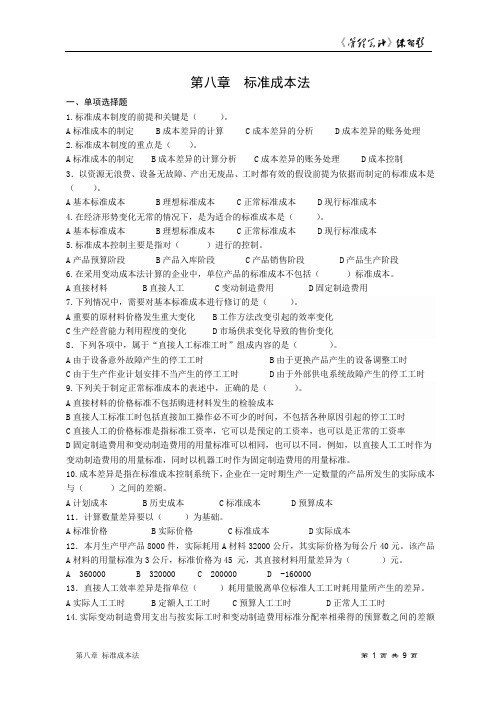
第八章标准成本法一、单项选择题1.标准成本制度的前提和关键是()。
A标准成本的制定 B成本差异的计算 C成本差异的分析 D成本差异的账务处理2.标准成本制度的重点是()。
A标准成本的制定 B成本差异的计算分析C成本差异的账务处理 D成本控制3.以资源无浪费、设备无故障、产出无废品、工时都有效的假设前提为依据而制定的标准成本是()。
A基本标准成本 B理想标准成本 C正常标准成本 D现行标准成本4.在经济形势变化无常的情况下,是为适合的标准成本是()。
A基本标准成本 B理想标准成本 C正常标准成本 D现行标准成本5.标准成本控制主要是指对()进行的控制。
A产品预算阶段 B产品入库阶段 C产品销售阶段 D产品生产阶段6.在采用变动成本法计算的企业中,单位产品的标准成本不包括()标准成本。
A直接材料B直接人工 C变动制造费用 D固定制造费用7.下列情况中,需要对基本标准成本进行修订的是()。
A重要的原材料价格发生重大变化B工作方法改变引起的效率变化C生产经营能力利用程度的变化D市场供求变化导致的售价变化8.下列各项中,属于“直接人工标准工时”组成内容的是()。
A由于设备意外故障产生的停工工时B由于更换产品产生的设备调整工时C由于生产作业计划安排不当产生的停工工时 D由于外部供电系统故障产生的停工工时9.下列关于制定正常标准成本的表述中,正确的是()。
A直接材料的价格标准不包括购进材料发生的检验成本B直接人工标准工时包括直接加工操作必不可少的时间,不包括各种原因引起的停工工时C直接人工的价格标准是指标准工资率,它可以是预定的工资率,也可以是正常的工资率D固定制造费用和变动制造费用的用量标准可以相同,也可以不同。
例如,以直接人工工时作为变动制造费用的用量标准,同时以机器工时作为固定制造费用的用量标准。
10.成本差异是指在标准成本控制系统下,企业在一定时期生产一定数量的产品所发生的实际成本与()之间的差额。
A计划成本 B历史成本 C标准成本 D预算成本11.计算数量差异要以()为基础。
第八章 德育练习题
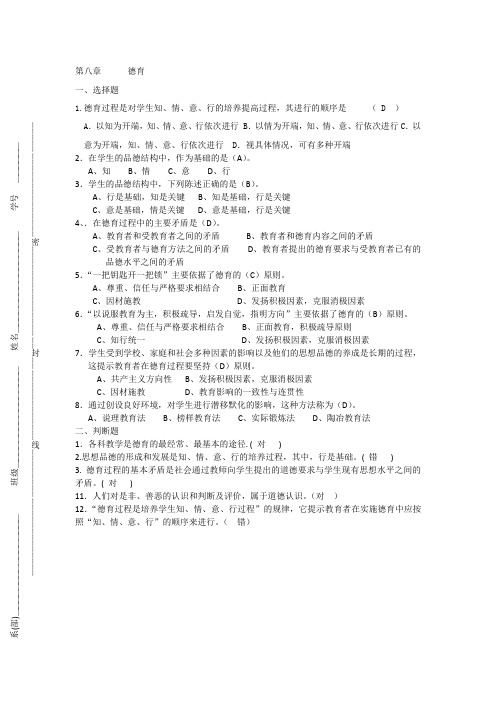
第八章 德育 一、选择题 1.德育过程是对学生知、情、意、行的培养提高过程,其进行的顺序是 ( D ) A .以知为开端,知、情、意、行依次进行 B .以情为开端,知、情、意、行依次进行C .以意为开端,知、情、意、行依次进行 D .视具体情况,可有多种开端 2.在学生的品德结构中,作为基础的是(A )。
A 、知 B 、情 C 、意 D 、行 3.学生的品德结构中,下列陈述正确的是(B )。
A 、行是基础,知是关键 B 、知是基础,行是关键 C 、意是基础,情是关键 D 、意是基础,行是关键 4、.在德育过程中的主要矛盾是(D )。
A 、教育者和受教育者之间的矛盾 B 、教育者和德育内容之间的矛盾 C 、受教育者与德育方法之间的矛盾 D 、教育者提出的德育要求与受教育者已有的品德水平之间的矛盾 5.“一把钥匙开一把锁”主要依据了德育的(C )原则。
A 、尊重、信任与严格要求相结合 B 、正面教育 C 、因材施教 D 、发扬积极因素,克服消极因素 6.“以说服教育为主,积极疏导,启发自觉,指明方向”主要依据了德育的(B )原则。
A 、尊重、信任与严格要求相结合 B 、正面教育,积极疏导原则 C 、知行统一 D 、发扬积极因素,克服消极因素 7.学生受到学校、家庭和社会多种因素的影响以及他们的思想品德的养成是长期的过程,这提示教育者在德育过程要坚持(D )原则。
A 、共产主义方向性 B 、发扬积极因素,克服消极因素 C 、因材施教 D 、教育影响的一致性与连贯性 8.通过创设良好环境,对学生进行潜移默化的影响,这种方法称为(D )。
A 、说理教育法 B 、榜样教育法 C 、实际锻炼法 D 、陶冶教育法 二、判断题 1.各科教学是德育的最经常、最基本的途径. ( 对 ) 2.思想品德的形成和发展是知、情、意、行的培养过程,其中,行是基础。
( 错 ) 3. 德育过程的基本矛盾是社会通过教师向学生提出的道德要求与学生现有思想水平之间的矛盾。
生理学-第八章尿的生成与排出练习题及答案.docx
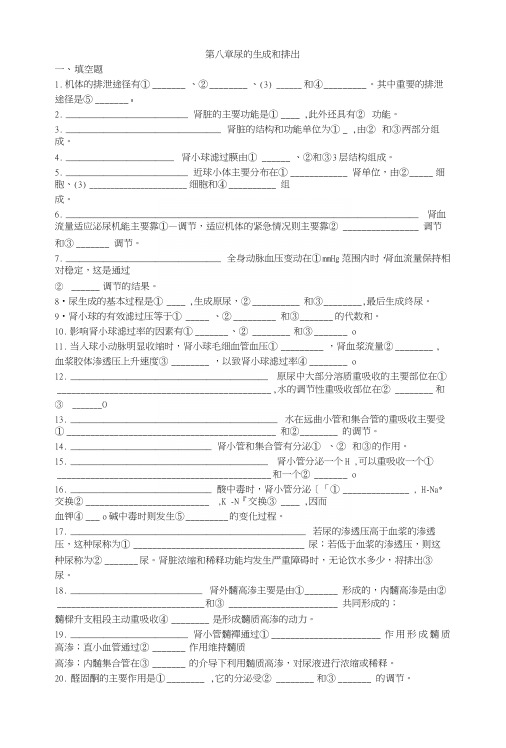
第八章尿的生成和排出一、填空题1.机体的排泄途径有①_______ 、②________ 、(3) ______ 和④_________ 。
其中重要的排泄途径是⑤_______ 02. __________________________ 肾脏的主要功能是①____ ,此外还具有②功能。
3. _________________________________ 肾脏的结构和功能单位为①_ ,由②和③两部分组成。
4. _______________________ 肾小球滤过膜由① ______ 、②和③3层结构组成。
5. __________________________ 近球小体主要分布在①____________ 肾单位,由②_____ 细胞、(3) _______________________ 细胞和④__________ 组成。
6. ___________________________________________________________________________ 肾血流量适应泌尿机能主要靠①—调节,适应机体的紧急情况则主要靠② ________________ 调节和③_______ 调节。
7. _________________________________ 全身动脉血压变动在①mmHg范围内时,肾血流量保持相对稳定,这是通过②______ 调节的结果。
8•尿生成的基本过程是① ____ ,生成原尿,②__________ 和③________ ,最后生成终尿。
9•肾小球的有效滤过压等于① _____ 、②_________ 和③_______ 的代数和。
10.影响肾小球滤过率的因素有①_______ 、② ________ 和③_______ o11.当入球小动脉明显收缩时,肾小球毛细血管血压①_________ ,肾血浆流量②________ , 血浆胶体渗透压上升速度③________ ,以致肾小球滤过率④________ o12. __________________________________________ 原尿中大部分溶质重吸收的主要部位在①_____________________________________________ ,水的调节性重吸收部位在② ________ 和③ _______ O13. ____________________________________________ 水在远曲小管和集合管的重吸收主要受①____________________________________________ 和②________ 的调节。
第八章 所有者权益练习题
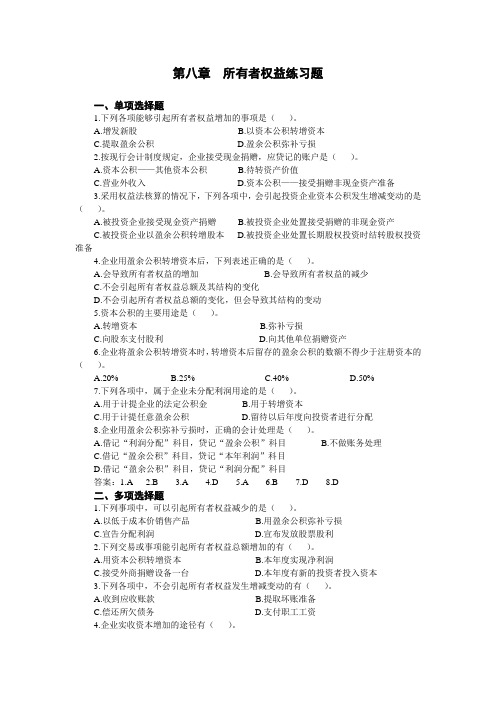
第八章所有者权益练习题一、单项选择题1.下列各项能够引起所有者权益增加的事项是()。
A.增发新股B.以资本公积转增资本C.提取盈余公积D.盈余公积弥补亏损2.按现行会计制度规定,企业接受现金捐赠,应贷记的账户是()。
A.资本公积——其他资本公积B.待转资产价值C.营业外收入D.资本公积——接受捐赠非现金资产准备3.采用权益法核算的情况下,下列各项中,会引起投资企业资本公积发生增减变动的是()。
A.被投资企业接受现金资产捐赠B.被投资企业处置接受捐赠的非现金资产C.被投资企业以盈余公积转增股本D.被投资企业处置长期股权投资时结转股权投资准备4.企业用盈余公积转增资本后,下列表述正确的是()。
A.会导致所有者权益的增加B.会导致所有者权益的减少C.不会引起所有者权益总额及其结构的变化D.不会引起所有者权益总额的变化,但会导致其结构的变动5.资本公积的主要用途是()。
A.转增资本B.弥补亏损C.向股东支付股利D.向其他单位捐赠资产6.企业将盈余公积转增资本时,转增资本后留存的盈余公积的数额不得少于注册资本的()。
A.20%B.25%C.40%D.50%7.下列各项中,属于企业未分配利润用途的是()。
A.用于计提企业的法定公积金B.用于转增资本C.用于计提任意盈余公积D.留待以后年度向投资者进行分配8.企业用盈余公积弥补亏损时,正确的会计处理是()。
A.借记“利润分配”科目,贷记“盈余公积”科目B.不做账务处理C.借记“盈余公积”科目,贷记“本年利润”科目D.借记“盈余公积”科目,贷记“利润分配”科目答案:1.A 2.B 3.A 4.D 5.A 6.B 7.D 8.D二、多项选择题1.下列事项中,可以引起所有者权益减少的是()。
A.以低于成本价销售产品B.用盈余公积弥补亏损C.宣告分配利润D.宣布发放股票股利2.下列交易或事项能引起所有者权益总额增加的有()。
A.用资本公积转增资本B.本年度实现净利润C.接受外商捐赠设备一台D.本年度有新的投资者投入资本3.下列各项中,不会引起所有者权益发生增减变动的有()。
8章时间序列分析练习题参考答案

第八章时间数列分析一、单项选择题1.时间序列与变量数列()A都是根据时间顺序排列的B都是根据变量值人小排列的C前者是根据时间顺序排列的,后者是根据变量值人小排列的D前者是根据变量值大小排列的,后者是根据时间顺序排列的C2.时间序列中,数值大小与时间长短有直接关系的是()A平均数时间序列B时期序列C时点序列D相对数时间序列B3.发展速度属于()A比例相对数B比较相对数C动态相对数D强度相对数C4.计算发展速度的分母是()A报告期水平B基期水平C实际水平D计划水平B则该车间上半年的平均人数约为()A 296 人B 292 人C 295 人D 300 人C6.某地区某年9月末的人口数为150万人,10月末的人口数为150. 2万人,该地区10月的人口平均数为()A 150万人B 150. 2万人C150. 1万人D无法确定C7.由一个9项的时间序列可以计算的环比发展速度()A有8个E有9个C有10个D有7个A8.采用几何平均法计算平均发展速度的依据是()A各年环比发展速度之枳等于总速度B各年坏比发展速度之和等于总速度C各年坏比增长速度之枳等于总速度D各年坏比增长速度之和等于总速度A9.某企业的科技投入,2010年比2005年增长了58. 6%,则该企业2006—2010年间科技投入的平均发展速度为()A V58.6%B V158.6%C ”58.6%D ”158.6%B10.根据牧区每个月初的牲畜存栏数计算全牧区半年的牲畜平均存栏数,采用的公式是()A简单平均法B几何平均法C加权序时平均法D首末折半法D11•在测定长期趋势的方法中,可以形成数学模型的是()A时距扩大法E移动平均法C最小平方法D季节指数法c12.动态数列中,每个指标数值相加有意义的是()。
A.时期数列B.时点数列C.相对数数列D.平均数数列A13•按几何平均法计算的平均发展速度侧重于考察现象的()A.期末发展水平B.期初发展水平C.中间各项发展水平D.整个时期各发展水平的总和A14.累计增长量与其相应的各逐期增长量的关系表现为()A.累计增长量等于相应各逐期增长量之和B.累计增长量等于相应各逐期增长量之差C.累计增长量等于相应各逐期增长量之积D.累计增长量等于相应各逐期增长量之商A15.已知某地区2010年的粮食•产量比2000年增长了1倍,比2005年增长了0. 5倍,那么2005年粮食•产量比2000年增长了()。
第八章 经济增长和经济发展理论练习题
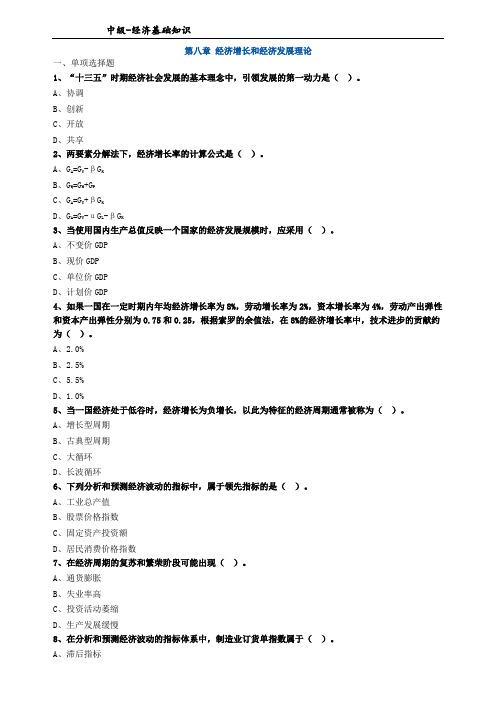
第八章经济增长和经济发展理论一、单项选择题1、“十三五”时期经济社会发展的基本理念中,引领发展的第一动力是()。
A、协调B、创新C、开放D、共享2、两要素分解法下,经济增长率的计算公式是()。
A、G A=G Y-βG KB、G Q=G H+G PC、G A=G Y+βG KD、G A=G Y-αG L-βG K3、当使用国内生产总值反映一个国家的经济发展规模时,应采用()。
A、不变价GDPB、现价GDPC、单位价GDPD、计划价GDP4、如果一国在一定时期内年均经济增长率为8%,劳动增长率为2%,资本增长率为4%,劳动产出弹性和资本产出弹性分别为0.75和0.25,根据索罗的余值法,在8%的经济增长率中,技术进步的贡献约为()。
A、2.0%B、2.5%C、5.5%D、1.0%5、当一国经济处于低谷时,经济增长为负增长,以此为特征的经济周期通常被称为()。
A、增长型周期B、古典型周期C、大循环D、长波循环6、下列分析和预测经济波动的指标中,属于领先指标的是()。
A、工业总产值B、股票价格指数C、固定资产投资额D、居民消费价格指数7、在经济周期的复苏和繁荣阶段可能出现()。
A、通货膨胀B、失业率高C、投资活动萎缩D、生产发展缓慢8、在分析和预测经济波动的指标体系中,制造业订货单指数属于()。
A、滞后指标B、一致指标C、先行指标D、同步指标9、经济发展的核心是()。
A、经济快速增长B、第三产业比重逐渐提高C、人民生活水平的持续提高D、农村人口向城市转移10、党的十九大报告在“加快完善社会主义市场经济体制”部分首先就指出,经济体制改革必须以()和要素市场化配置为重点。
A、完善产权制度B、完善交易制度C、完善金融制度D、完善政府监管制度二、多项选择题1、转变经济发展方式的具体内容主要是促进“三个转变”,这“三个转变”是指()。
A、促进经济增长向依靠投资、出口拉动转变B、促进经济增长向依靠消费、投资、出口协调拉动转变C、促进经济增长向依靠第二产业带动转变D、促进经济增长向依靠第一、第二、第三产业协同带动转变E、促进经济增长向主要依靠科技进步、劳动者素质提高、管理创新转变2、党的十八届五中全会明确提出了“十三五”时期经济社会发展的基本理念是()。
- 1、下载文档前请自行甄别文档内容的完整性,平台不提供额外的编辑、内容补充、找答案等附加服务。
- 2、"仅部分预览"的文档,不可在线预览部分如存在完整性等问题,可反馈申请退款(可完整预览的文档不适用该条件!)。
- 3、如文档侵犯您的权益,请联系客服反馈,我们会尽快为您处理(人工客服工作时间:9:00-18:30)。
第八章1. The assumptions of the traditional approaches to exchange rate and balance ofpayments determination reflect the fact that:A. they were developed during the time of the gold standard and the early BrettonWoods systems.B. economists had not yet recognized the importance of monetary factors at thetime they were developed.C. there were sizable capital flows between industrialized countries at the timethey were developed.D. the Keynesian school of thought had not permeated international theory at thetime they were developed.Answer: A2. The size of trade flows relative to capital flows is:A. considerably larger.B. roughly equal due to trade balances effects.C. exactly equal due to double entry accounting.D. quite minuscule.Answer: D3. The traditional approaches to exchange rate and balance of paymentsdetermination assume that capital flows occur:A. at the time of transactions.B. only as a means of financing current account transactions.C. largely between countries of equal size and wealth.D. in relatively unpredictable waves determined by the animal spirits of investors.Answer: B4. The elasticity of the export supply in turn determines the elasticity of the:A. demand for foreign exchange.B. supply of foreign exchange.C. demand for domestic currency.D. supply of domestic currency.Answer: A5. The more elastic is the export supply curve, the:A. less elastic is the demand for domestic currency.B. more elastic is the supply of domestic currency.C. less elastic is the supply of foreign exchange.D. more elastic is the demand for foreign exchange.Answer: D6. The import demand curve determines the _____in the same way that the exportsupply curve determines the ______.A. supply of domestic currency; demand for domestic currency.B. demand for domestic currency; supply of domestic currency.C. supply of foreign exchange; demand for foreign exchange.D. demand for foreign exchange; supply of foreign exchange.Answer: C7. The more elastic is the import demand curve, the:A. more elastic is the foreign exchange demand curve.B. less elastic is the foreign exchange demand curve.C. more elastic is the foreign exchange supply curve.D. less elastic is the foreign exchange supply curve.Answer: C8. The elasticities approach emphasizes the effects of changes in _______ indetermining the of balance of payments and the exchange rate.A. the quantities of goods.B. the relative supply of moneyC. the prices of goodsD. real incomeAnswer: C9. According to the elasticities approach, the elasticities of the import demand andexport supply curves determine how much the quantity of imports demanded and the quantity of exports supplied will change in response to:A. a shift in consumer tastes.B. a change in the exchange rate.C. trade restrictions placed on imports and exports.D. the business cycle.Answer: B10. The Marshall-Lerner condition specifies:A. a necessary condition for exchange rate stability.B. a sufficient condition for exchange rate instability.C. when a central bank should intervene in foreign exchange markets.D. the guidelines set forth in GATT.Answer: A11. The Marshall-Lerner condition holds when the:A. sum of the elasticities of import demand and export supply exceed one.B. difference in the elasticites of import demand and export supply exceed one.C. difference in the absolute values of the elasticites of import demand and exportsupply exceed one.D. sum of the absolute values of the elasticities of import demand and exportssupply exceed one.Answer: D12. The reason one expects supply and demand to be more price elastic over longertime periods is because:A. goods with longer shelf life have higher elasticities.B. there are feedback affects which alter the initial response.C. time is needed for households and businesses to adjust to price changes.D. the elasticity of supply always exceeds that of demand.Answer: C13. A phenomenon in which a depreciation of the domestic currency causes a nation'sbalance of payments to worsen before it improves is called:A. the J-curve effect.B. the S-curve effect.C. devaluation.D. pass-through effects.Answer: A14. The basic assumption underlying the J-curve effect is that:A. people are myopic in their views of how the exchange rate will evolve over time.B. initially, supply will exceed demand but in equilibrium the two will be equated.C. supply and demand are less elastic in the short run than in the long run.D. an overshooting effect occurs as people change their investment horizons.Answer: C15. The idea that a country's trade balance may first deteriorate after a currencydevaluation and only later improve is known as:A. the relative price effect.B. the elasticity effect.C. the pass through affect.D. the J-Curve.Answer: D16. The effect of a currency depreciation that results in higher domestic prices ofimported goods and services is known as:A. the pass-out effect.B. the pass-through effect.C. cost-push inflation.D. demand-pull inflation.Answer: B17. One explanation for why a full pass-through to domestic prices is not alwaysobserved is that:A. the exchange rate is fixed.B. the exchange rate is floated yet managed.C. domestic firms respond with temporary price changes in order to maintainmarket shares.D. foreign firms view the change in the exchange rate as temporary and alter theirprices accordingly.Answer: D18. The absorption approach to exchange rate and balance of payments determinationis based on:A. the relative prevalence of traded goods in an economy.B. demographic trends which alter the demand for imports.C. how much of GDP is consumed by government.D. the difference between real income and absorption levels.Answer: D19. Which of the following is not included in a nation's expenditures?A. Consumption.B. Investment.C. Government spending.D. Exports.Answer: D20. Domestic absorption includes expenditures on final goods and services in whichfour basic categories?A. Consumption, investment, government, and exports.B. Consumption, investment, exports, and imports.C. Consumption, investment, government, and imports.D. Investment, government, exports, and imports.Answer: C21. The current account is defined as the:A. sum of exports and imports.B. product of exports and imports.C. ratio of imports to exportsD. difference between exports and imports.Answer: D22. A nation is running a current account deficit if:A. imports are less than exports and real income is less than absorption.B. imports are less than exports and absorption is less than real income.C. exports are less than imports and real income is less than absorption.D. exports are less than imports and absorption is less than real income.Answer: C23. The difference between real income and absorption is equal to theA. current account.B. public budget deficit.C. exchange-rate.D. net national product.Answer: A24. Devaluation of the domestic currency will induceA. expenditure switching.B. a flow of capital out of the country.C. a revaluation once the trade balance has stabilized.D. accompanying trade restrictions.Answer: A25. The portfolio approach is believed to have been developed initially byA. Stanley Fischer.B. Sidney Alexander.C. Milton Friedman.D. Robert Lucas.Answer: B26. In the absorption approach, under adjustable-pegged exchange rates,policymakers have access to which two policy instruments?A. Taxes and government spending.B. Federal funds rate and the discount rate.C. Trade restrictions and foreign exchange intervention.D. Absorption and expenditures-switching.Answer: D。
